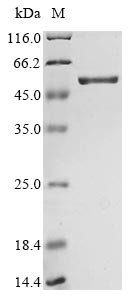Recombinant Human SARS coronavirus Nucleoprotein is produced in E. coli and comprises the full-length sequence of 422 amino acids. This protein carries an N-terminal 6xHis tag for affinity purification, reaching a purity level greater than 90%, as determined by SDS-PAGE. It's intended for research use only and contains no detectable endotoxins, which appears to make it suitable for various experimental applications.
The SARS coronavirus Nucleoprotein (N) seems to play a crucial role in the viral life cycle, particularly in the packaging and assembly of the viral genome. It's involved in viral RNA replication and transcription, making it a key target for research related to viral pathogenesis and immune response. Understanding this protein may be essential for grasping coronavirus biology and developing therapeutic strategies.
Potential Applications
Note: The applications listed below are based on what we know about this protein's biological functions, published research, and experience from experts in the field. However, we haven't fully tested all of these applications ourselves yet. We'd recommend running some preliminary tests first to make sure they work for your specific research goals.
The protein is expressed in E. coli, a prokaryotic system lacking eukaryotic post-translational modifications (PTMs). While full-length (1–422 aa) and tagged with an N-terminal 6xHis tag (which improves solubility), no direct evidence of correct folding (e.g., circular dichroism for secondary structure, thermal shift assays for stability) or native bioactivity (e.g., RNA binding, oligomerization, or interaction with viral/host partners) is provided. E. coli often produces inclusion bodies for nucleocapsid proteins, even with His tags—though 85% purity suggests partial solubility. The protein may adopt a non-native conformation, limiting its ability to mimic wild-type SARS-CoV N function.
1. Antibody Development and Validation
This full-length recombinant SARS-CoV N protein can serve as an immunogen for generating antibodies, but antibody specificity must be validated against native N—E. coli-expressed protein may present non-native epitopes, leading to cross-reactivity with irrelevant targets. The 6xHis tag aids purification/immobilization for ELISA screening, but high purity alone does not guarantee minimal cross-reactivity; validation with native N or infected cells is critical.
2. Protein-Protein Interaction Studies
Pull-down assays using the 6xHis tag can identify binding partners, but results depend on correct folding—E. coli-expressed N may fail to bind viral RNA or host factors natively. Identified interactors must be validated via co-IP or functional assays to rule out artifacts from misfolding. The full length supports studying interactions, but bioactivity (e.g., RNA binding) is unconfirmed.
3. Structural and Biochemical Characterization
This full-length N protein can support preliminary structural studies (e.g., CD for secondary structure, DLS for stability), but crystallography/NMR may be hindered by misfolding. Biochemical assays (e.g., oligomerization) can assess conformational changes, but results must be contextualized by limited folding guarantees. The His tag aids purification, but structural conclusions require comparison to native N.
4. Immunoassay Development and Optimization
This protein is a useful reference standard for immunoassays, but its representativeness of native N must be confirmed. The 6xHis tag enables consistent immobilization, but assay performance (e.g., sensitivity, specificity) may differ if the protein adopts a non-native structure. Validate with native N or clinical samples to ensure relevance.
5. Viral Assembly and RNA Binding Studies
The recombinant N protein may inform in vitro assembly studies, but RNA binding and oligomerization are unvalidated—E. coli-expressed N often lacks the correct disulfide bonds or RNA-binding pocket geometry. Results are tentative and require confirmation with native N or viral particles. Gel shift/fluorescence assays can explore binding, but functionality is not guaranteed.
Final Recommendation & Action Plan
This E. coli-expressed, full-length SARS-CoV N protein has potential for antibody development or immunoassay standardization but requires urgent validation of folding and bioactivity first, confirm secondary/tertiary structure via CD spectroscopy and thermal shift assays; second, validate RNA binding and oligomerization using biochemical assays; third, optimize expression (e.g., lower temperature, co-express chaperones) to improve solubility/native folding. For interaction or assembly studies, pair with co-IP/functional assays to rule out misfolding artifacts. If validation fails, use a eukaryotic system (e.g., mammalian/insect cells) to ensure native structure, or refold the protein in vitro. Always include native N controls to contextualize results.






